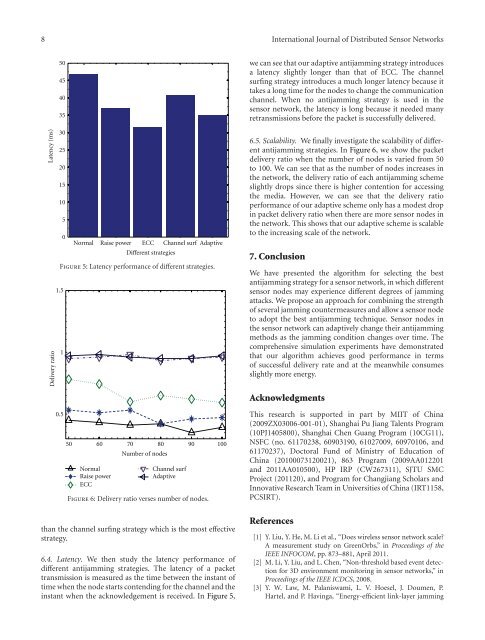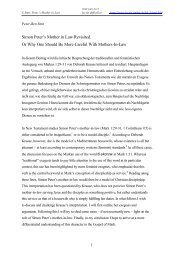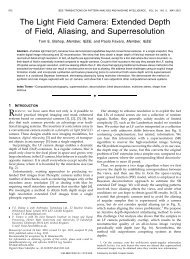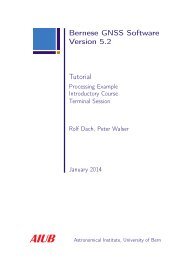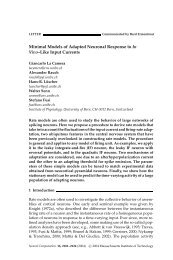Deploying Real-Life WSN Applications: Challenges ... - IAM - CDS
Deploying Real-Life WSN Applications: Challenges ... - IAM - CDS
Deploying Real-Life WSN Applications: Challenges ... - IAM - CDS
You also want an ePaper? Increase the reach of your titles
YUMPU automatically turns print PDFs into web optimized ePapers that Google loves.
8 International Journal of Distributed Sensor Networks<br />
Latency (ms)<br />
Delivery ratio<br />
50<br />
45<br />
40<br />
35<br />
30<br />
25<br />
20<br />
15<br />
10<br />
5<br />
0<br />
Normal Raise power ECC Channel surf Adaptive<br />
Different strategies<br />
Figure 5: Latency performance of different strategies.<br />
1.5<br />
1<br />
we can see that our adaptive antijamming strategy introduces<br />
a latency slightly longer than that of ECC. The channel<br />
surfing strategy introduces a much longer latency because it<br />
takes a long time for the nodes to change the communication<br />
channel. When no antijamming strategy is used in the<br />
sensor network, the latency is long because it needed many<br />
retransmissions before the packet is successfully delivered.<br />
6.5. Scalability. We finally investigate the scalability of different<br />
antijamming strategies. In Figure 6, we show the packet<br />
delivery ratio when the number of nodes is varied from 50<br />
to 100. We can see that as the number of nodes increases in<br />
the network, the delivery ratio of each antijamming scheme<br />
slightly drops since there is higher contention for accessing<br />
the media. However, we can see that the delivery ratio<br />
performance of our adaptive scheme only has a modest drop<br />
in packet delivery ratio when there are more sensor nodes in<br />
the network. This shows that our adaptive scheme is scalable<br />
to the increasing scale of the network.<br />
7. Conclusion<br />
We have presented the algorithm for selecting the best<br />
antijamming strategy for a sensor network, in which different<br />
sensor nodes may experience different degrees of jamming<br />
attacks. We propose an approach for combining the strength<br />
of several jamming countermeasures and allow a sensor node<br />
to adopt the best antijamming technique. Sensor nodes in<br />
the sensor network can adaptively change their antijamming<br />
methods as the jamming condition changes over time. The<br />
comprehensive simulation experiments have demonstrated<br />
that our algorithm achieves good performance in terms<br />
of successful delivery rate and at the meanwhile consumes<br />
slightly more energy.<br />
Acknowledgments<br />
0.5<br />
50 60 70 80 90 100<br />
Normal<br />
Raise power<br />
ECC<br />
Number of nodes<br />
Channel surf<br />
Adaptive<br />
Figure 6:Deliveryratioversesnumberofnodes.<br />
This research is supported in part by MIIT of China<br />
(2009ZX03006-001-01), Shanghai Pu Jiang Talents Program<br />
(10PJ1405800), Shanghai Chen Guang Program (10CG11),<br />
NSFC (no. 61170238, 60903190, 61027009, 60970106, and<br />
61170237), Doctoral Fund of Ministry of Education of<br />
China (20100073120021), 863 Program (2009AA012201<br />
and 2011AA010500), HP IRP (CW267311), SJTU SMC<br />
Project (201120), and Program for Changjiang Scholars and<br />
Innovative Research Team in Universities of China (IRT1158,<br />
PCSIRT).<br />
than the channel surfing strategy which is the most effective<br />
strategy.<br />
6.4. Latency. We then study the latency performance of<br />
different antijamming strategies. The latency of a packet<br />
transmission is measured as the time between the instant of<br />
time when the node starts contending for the channel and the<br />
instant when the acknowledgement is received. In Figure 5,<br />
References<br />
[1] Y. Liu, Y. He, M. Li et al., “Does wireless sensor network scale?<br />
A measurement study on GreenOrbs,” in Proceedings of the<br />
IEEE INFOCOM, pp. 873–881, April 2011.<br />
[2] M. Li, Y. Liu, and L. Chen, “Non-threshold based event detection<br />
for 3D environment monitoring in sensor networks,” in<br />
Proceedings of the IEEE ICDCS, 2008.<br />
[3] Y. W. Law, M. Palaniswami, L. V. Hoesel, J. Doumen, P.<br />
Hartel, and P. Havinga, “Energy-efficient link-layer jamming


